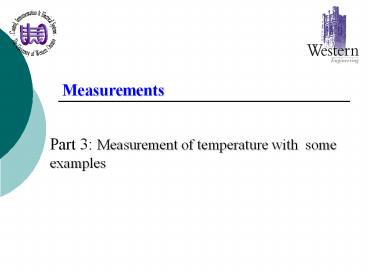Measurements - PowerPoint PPT Presentation
1 / 30
Title:
Measurements
Description:
To understand the principle of bridge circuit and be able to perform simple ... Suppose that a volt meter of infinite impedance (Ig = 0) is used to measure the ... – PowerPoint PPT presentation
Number of Views:91
Avg rating:3.0/5.0
Title: Measurements
1
Measurements
- Part 3 Measurement of temperature with some
examples
2
Learning objectives
- To understand the principle of bridge circuit
and be able to perform simple calculations to use
bridge to measure low level voltages - To be able to determine the temperature from an
RTD sensor reading - To be able to calculate the temperature from an
thermistor reading - To be able to calculate the temperature from an
thermocouple reading - To be able to understand the basic concept of
D/A and A/D converters and calculate quantization
errors.
3
Bridge circuits
Bridge circuit is used quite often to measure low
level voltages, such as the outputs from RTD,
thermister, or thermocouples.
In the case of a balanced bridge, there is no
voltage drop between, B and C, hence, Ig 0. We
have
4
Bridge circuits (Cont)
Furthermore,
and
Therefore, the following condition is established
for a balanced bridge
Any change in one arm of the bridge will destroy
this balance condition. However, one can use the
measured voltage across the bridge to calculate
changes in one arm.
5
Bridge circuits (Cont)
Suppose that a volt meter of infinite impedance
(Ig 0) is used to measure the voltage across
points B and C. Because (Ig 0),
The voltage drop will be
Of course, under a balanced condition,
6
Bridge circuits (Cont)
Under this condition, suppose that there is a
change in R1, such that
The corresponding change in voltage across B and
C is
To simplify the analysis, if we assume that
7
Bridge circuits (Cont)
Then
Or
8
Bridge circuits (Cont)
Example
An RTD is connected in a Wheatstone bridge as
shown
Under a balanced condition, the parameters are
given as follows
The temperature constant of the RTD
9
Bridge circuits (Cont)
Questions (a) What is the value of RRTD under
the balanced condition ?
(b) As temperature changes, it is found that the
maintain a new balance, the new value for R1 has
to be
Determine the change in temperature.
Solution
(a) Using the relation
10
Bridge circuits (Cont)
(b) Since the relationship between the resistance
of the RTD and the temperature change can be
approximated by
At the newly established balance condition with
We can conclude that
11
Temperature measurement with RTD
Typical characteristics of RTD
12
Temperature measurement with RTD
For RTD made of platinum, the temperature profile
is quite linear and can be represented by
For RTD made of copper, the characteristics can
be approximated by
13
Temperature measurement with RTD
Example
A platinum RTD is connected as one arm of a
Wheatstone bridge as shown
The fixed resistors, R2 and R3 are 25O. The RTD
has a resistance of 25O at 0oC, and the
coefficient of resistance of the RTD is
14
Temperature measurement with RTD
A temperature measurement is made by placing the
RTD in the measuring environment and balancing
the bridge by adjusting R1 to a new value of
37.36 O. Determine the temperature of the
measuring environment
Solution
At balanced condition, we have
From
We can find that the temperature is 126o C.
15
Temperature measurement with thermistors
The mathematical relationship describing a
thermistor can often be expressed as
As temperature increases, the resistance
decreases.
R0 is the resistance at T0, and ß is a parameter
ranging from 3500 to 4600.
16
Temperature measurement with thermistors
Example
A thermistor is placed in a 100oC environment,
and its resistance is measured at 20,000O. The
material constant, ß, for this thermistor is
4000. If the thermistor is then used to measure a
particular temperature, and its resistance is
measured as 500 O, determine the environmental
temperature being measured.
17
Temperature measurement with thermistors
Solution
From the basic equation of thermistor, we can have
Further
18
Temperature measurement with thermocouples
10
19
Temperature measurement with thermocouples
Standard Thermocouple Compositions
20
Thermocouples Example
Example
A type-J thermocouple circuit below is used to
measure the temperature T1 . The thermocouple
junction 2 is maintained by 32o F. The voltage
output is measured to be 15 mV. Determine the
temperature T1.
Solution
The temperature T can be read off from the graph
for type-J thermocouple to be 530o F.
21
Temperature measurement with thermocouples
10
22
Quantization error and resolution
23
Digital to analog converter (DAC)
DAC is a device which converts a digital value to
analog one. The general circuit is shown below
24
Digital to analog converter (DAC)
Suppose a n-bit digital value is represented as
where
can be either 1 or 0.
Its corresponding analog value can be calculated
as
25
Digital to analog converter (DAC) Example
Example
Suppose an 8-bit digital value is given as
Vd 1 1 0 1 0 0 1 0
Convert this digital value to a corresponding
analog representation using a DAC with VR of 12
volts, and assess the largest quantization error.
26
Digital to analog converter (DAC) Example
Solution
Since
The DAC output can be calculated as
or
V
The quantization error is
V
27
Analog to digital converter (ADC)
Successive approximation ADC
28
Analog to digital converter (ADC) Example
Example
For a 4-bit ADC converter as shown below, go
through the conversion process when a voltage of
10.1 V is being converted to digital
representation with the full scale analog voltage
of 15 V.
Solution
The step size of this 4-bit converter is
V
The quantization error is
29
Analog to digital converter (ADC) Example
30
Analog to digital converter (ADC) Example
MSB Most Significant Bit LSB Least Significant
Bit
For 1011, the error is
For 1010, the error is































